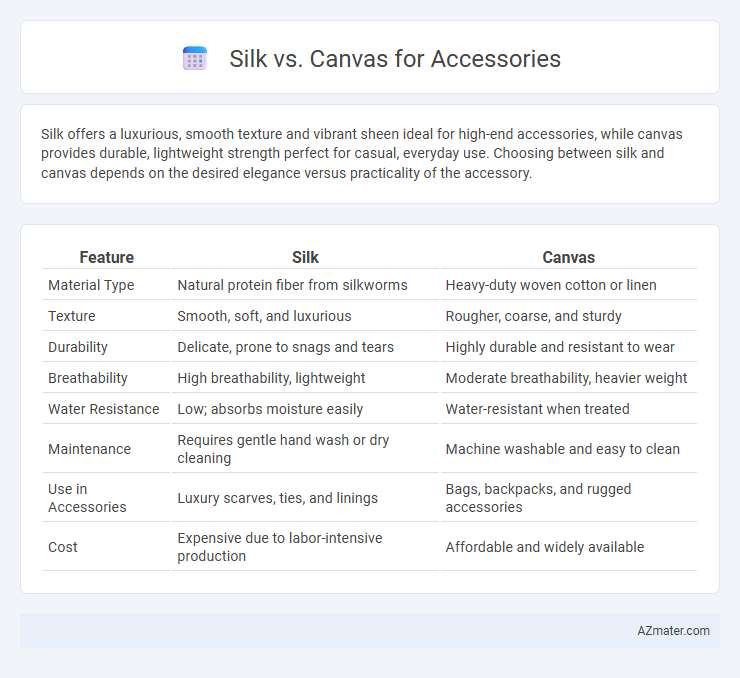Silk offers a luxurious, smooth texture and vibrant sheen ideal for high-end accessories, while canvas provides durable, lightweight strength perfect for casual, everyday use. Choosing between silk and canvas depends on the desired elegance versus practicality of the accessory.
Table of Comparison
| Feature | Silk | Canvas |
|---|---|---|
| Material Type | Natural protein fiber from silkworms | Heavy-duty woven cotton or linen |
| Texture | Smooth, soft, and luxurious | Rougher, coarse, and sturdy |
| Durability | Delicate, prone to snags and tears | Highly durable and resistant to wear |
| Breathability | High breathability, lightweight | Moderate breathability, heavier weight |
| Water Resistance | Low; absorbs moisture easily | Water-resistant when treated |
| Maintenance | Requires gentle hand wash or dry cleaning | Machine washable and easy to clean |
| Use in Accessories | Luxury scarves, ties, and linings | Bags, backpacks, and rugged accessories |
| Cost | Expensive due to labor-intensive production | Affordable and widely available |
Overview: Silk vs Canvas for Accessories
Silk offers a smooth, lustrous texture and natural sheen, making it ideal for luxurious accessories like scarves and ties, while canvas provides a sturdy, durable fabric suitable for bags and belts. The lightweight, breathable properties of silk contrast with the heavy-duty, rugged nature of canvas, influencing the accessory's functionality and style. Choosing between silk and canvas depends on the desired aesthetic, durability, and use-case of the accessory.
Material Composition: Silk and Canvas Explained
Silk is a natural protein fiber derived from silkworms, renowned for its smooth texture, lightweight feel, and luxurious sheen, making it ideal for high-end accessories. Canvas, typically made from cotton or linen fibers, is a durable, coarse fabric well-suited for casual and utilitarian accessories due to its sturdy texture and resistance to wear. Understanding the material composition highlights silk's elegance and softness versus canvas's robustness and practicality in accessory design.
Durability and Longevity
Silk offers a luxurious texture but is less durable and prone to tearing and abrasion compared to canvas, which is woven tightly from cotton or synthetic fibers and excels in wear resistance. Canvas accessories maintain their shape and color longer, resisting fraying and stains under regular use, making them ideal for high-traffic items. The longevity of silk accessories often requires careful handling and dry cleaning, while canvas can withstand frequent washing and rough conditions without significant degradation.
Texture and Aesthetic Appeal
Silk offers a smooth, luxurious texture that enhances the elegance of accessories with its natural sheen and soft drape, making it ideal for high-end, delicate items. Canvas provides a sturdy, textured surface with a matte finish, lending a casual and rugged aesthetic perfect for durable, everyday accessories. The choice between silk and canvas significantly influences the tactile experience and visual sophistication of the accessory, aligning with different style preferences and functional needs.
Weight and Comfort Considerations
Silk accessories are prized for their lightweight and smooth texture, offering exceptional comfort and breathability, ideal for extended wear. Canvas, being heavier and more rigid, provides greater durability but may feel less comfortable during long periods of use. Choosing between silk and canvas depends on the balance between desired comfort and the need for sturdiness in accessory design.
Color Vibrancy and Print Quality
Silk offers exceptional color vibrancy and a luminous finish, making printed accessories appear rich and vivid with sharp, detailed designs. Canvas, while durable and textured, tends to absorb ink more, resulting in slightly muted colors and less crisp print quality compared to silk. For accessories where bright, bold visuals and high-definition prints are essential, silk remains the superior choice over canvas.
Maintenance and Care Requirements
Silk accessories require gentle hand washing or dry cleaning to maintain their delicate fibers and vibrant sheen, avoiding exposure to direct sunlight and harsh chemicals to prevent damage and fading. Canvas accessories offer higher durability with easy maintenance, allowing machine washing or spot cleaning without significant wear, making them ideal for everyday use. Proper storage for both materials is crucial: silk should be kept away from moisture and stored flat, while canvas benefits from being stored in a dry, ventilated area to prevent mold and mildew.
Environmental Impact and Sustainability
Silk production involves intensive use of water and energy, and often relies on chemical-laden processes, whereas canvas, typically made from organic cotton or hemp, tends to have a lower environmental footprint due to its biodegradability and renewable crop sources. Canvas production supports sustainable agriculture practices with less pesticide use and higher durability, reducing the frequency of replacement and waste. Choosing canvas accessories promotes eco-friendly consumption by reducing resource depletion and supporting carbon sequestration through plant-based materials.
Price Comparison: Silk vs Canvas
Silk accessories typically command higher prices due to the luxurious feel, intricate production process, and premium raw materials involved, with costs often ranging from $50 to $200 per item. Canvas accessories offer a more affordable alternative, usually priced between $10 and $50, attributed to the durability and lower production costs of cotton or synthetic fibers. The price disparity reflects the targeted market segments, with silk appealing to luxury buyers and canvas catering to budget-conscious consumers seeking functionality.
Best Uses for Each Material in Accessories
Silk offers a smooth, luxurious texture ideal for high-end scarves, ties, and delicate hair accessories that require a soft drape and vibrant color retention. Canvas provides durability and rigidity, making it perfect for structured bags, wallets, and watch straps that benefit from its strong, hard-wearing nature. Each material enhances the accessory's function: silk for elegance and comfort, canvas for sturdiness and longevity.

Infographic: Silk vs Canvas for Accessory
 azmater.com
azmater.com